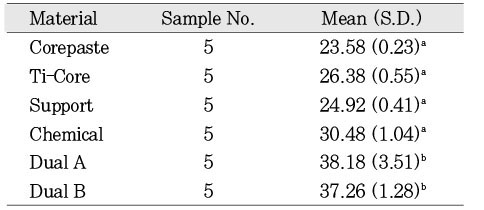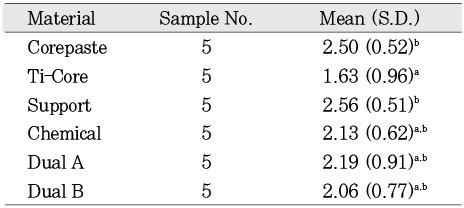Articles
- Page Path
- HOME > Restor Dent Endod > Volume 29(2); 2004 > Article
- Original Article A study on the material properties of various composite resins for core build-up
- Soo-Il Shin, Dong-Hoon Shin
-
2004;29(2):-199.
DOI: https://doi.org/10.5395/JKACD.2004.29.2.191
Published online: March 31, 2004
Department of Conservative Dentistry, College of Dentistry, Dankook University, Korea.
- Corresponding author: Dong-Hoon Shin. Department of Conservative Dentistry, School of Dentistry, Dankook University, San 7-1, Shinbu-dong, CheanAn, ChungNam, Korea, 330-716. Tel: 82-41-550-1965, Fax: 82-41-550-1963, donyshin@dku.edu
Copyright © 2004 Korean Academy of Conservative Dentistry
- 950 Views
- 1 Download
- 1 Crossref
Abstract
-
The purposes of this study were to estimate the material properties of the recently developed domestic composite resins for core filling material (Chemical, Dual A, Dual B; Vericom, Korea) and to compare them with other marketed foreign products (CorePaste, Den-Mat, USA; Ti-Core, Essential Dental Systems, USA; Support, SCI-Pharm, USA). Six assessments were made; working time, setting time, depth of polymerization, flexural strength, bonding strength, and marginal leakage. All items were compared to ISO standards.All domestic products satisfied the minimum requirements from ISO standards (working time: above 90 seconds, setting time: within 5 minutes), and showed significantly higher flexural strength than Core Paste. Dual A and B could, especially, reduce the setting time to 60 seconds when cured with 600 mW/cm2 light intensity. All experimental materials showed 6 mm depth of polymerization.Bond strengths of Ti-Core and Dual B materials were significantly higher than the other materials. Furthermore, three domestic products and Ti-Core could reduce the microleakage effectively.
- 1. Sorensen JA, Martinoff JT. Intracoronal reinforcement and coronal coverage: A study of endodontically treated teeth. J Prosthet Dent. 1984;51: 780-784.ArticlePubMed
- 2. Combe EC, Shaglouf A-MS, Watts DC, Wilson NHF. Mechanical properties of direct core build-up materials. Dent Mater. 1999;15: 158-165.ArticlePubMed
- 3. Cohen S, Burns RC. Pathway of the pulp. 1999;7th edition. Mosby; 703-704.
- 4. Saygili G, Mahmali SM. Comparative study of the Physical properties of core materials. Int J Periodontics Restorative Dent. 2002;22(4):355-363.PubMed
- 5. O'Keefe KL, Power JM. Adhesion of resin composite core materials to dentin. Int J Prosthodont. 2001;14(5):451-456.PubMed
- 6. Tjan AHL, Dunn JR, Lee JKY. Fracture resistance of amalgam and composite resin cores retained by various intradentinal retentive features. Quintessence Int. 1993;24: 211-217.PubMed
- 7. Ziebert AJ, Dhuru VB. The fracture toughness of various core materials. J Prosthodont. 1995;4: 33-37.ArticlePubMed
- 8. Ryu KH, Choi HY, Choi KK, Park SJ. A Study on the Mechanical Properties of Experimental, Composites Containing Zirconia Filler. J Korean Acad Conserv Dent. 2000;25(3):421-434.
- 9. Taleghani M, Bokmeyer T. Evaluation of titanium reinforced composite as a core build-up material (astr). J Dent Res. 1992;72: 1947.
- 10. Cohen BI, Deutsch AS, Condos S, Musikant BL, Scherer W. Compressive and diametral tensile strenghth of titanium reinforced composites. J Esthet Dent. 1992;4: suppl. 50-55.
- 11. Sturdevant CM. The art and science of operative dentistry. 1994;3rd edition. Mosby; 279-280.
- 12. Johnson JK, Shwartz NL, Backwell RI. Evaluation and restoration of endodontically treated posterior teeth. J Am Dent Assoc. 1976;93: 597-605.ArticlePubMed
- 13. Plasmans PJ, Vesseren LGH, Vrijhoef MMA, Kyser AF. In vitro comparison of dowel and core techniques for endodontically treated molars. J Endod. 1986;12: 382-387.ArticlePubMed
- 14. Rosen H. Operative procedures in mutilated endodontically treated posterior teeth. J Prosthet Dent. 1961;11: 973-986.
- 15. Varga J, Matsumara H, Masuhara E. Bonding of amalgam filling to tooth cavity with adhesive resin. Dent Mater J. 1986;5: 158-164.ArticlePubMed
- 16. Schwartz RS, Summitt JB, Robbins JW. Fundamentals of operative dentistry. 1996;1st edition. USA: Quintessence Publishing Co., Ltd; 149.
- 17. Hwang IN. Core Material Selection and Procedure. J Korean Dent Assoc. 2001;39(2):29-34.
- 18. Wilson AD, Kent BE. The glass-ionomer cement, a new translucent cement for dentistry. J Appl Chem Biotechnol. 1971;21: 313.
- 19. Mount GJ. Glass-ionomer cements: Past, present and future. Oper Dent. 1994;19: 82-90.PubMed
- 20. Burgess J, Norling B, Summitt J. Resin ionomer restorative materials: The new generation. J Esthet Dent. 1994;6: 207-215.ArticlePubMed
- 21. Sidhu SK, Watson TF. Resin ionomer restorative materials: The new generation. Am J Dent. 1995;8: 59.PubMed
- 22. Oliva RA, Lowe JA. Dimensional stability of composite used as a core material. J Prosthet Dent. 1986;56: 554-561.ArticlePubMed
- 23. Cook WD, Forrest M, Goodwin AA. A simple method for the measurement of polymerization shrinkage in dental composites. Dent Mater. 1999;15(6):447-449.ArticlePubMed
- 24. Davidson CS, de Gee AJ. Relaxation of polymerization contraction stress by flow in dental composites. J Dent Res. 1984;63: 146-148.ArticlePubMedPDF
- 25. Lutz F, Krejci I, Oldenburg TR. Elimination of polymerization stresses at the margins of posterior composite resin restorations: A new restorative technique. Quintessence Int. 1986;17: 659-664.PubMed
- 26. Imai Y, Kadoma Y, Kojima K, Akimoto T, Ikakura K, Ohta T. Importance of polymerization initiator systems and interfacial initiation of polymerization in adhesive bonding of resin to dentin. J Dent Res. 1991;70: 1088-1091.ArticlePubMedPDF
- 27. Torstenson B, Branstrom M. Contraction gap under composite resin restoration. ; effect hygroscopic expansion and thermal stress. Oper Dent. 1988;13: 24-31.PubMed
- 28. Cattani-Lorente MA, Dupuis V, Payan J, Moya F, Meter JM. Effect of water on the physical properties of resin-modified glass ionomer cements. Dent Mater. 1999;15: 71-78.ArticlePubMed
- 29. Craig RG. Restorative dental materials. 1997;10th edition. St Louis: Mosby.
- 30. Levartovsky S, Kuyinu E, Georgescu M, Goldstein GR. A comparison of the diametral tensile strength, the flexural strength, and the compressive strength of two new core materials to a silver alloy-reinforced glass-ionomer material. J Prosthet Dent. 1994;72: 481-485.PubMed
- 31. Matsumura H, Sueyoshe M, Atsuta M. Radiopacity and physical properties of titanium-polymethacrylate composite. J Dent Res. 1992;71(1):2-6.ArticlePubMedPDF
- 32. Abdalla A, Davison C. Shear bond strength and microleakage of new dentin bonding systems. Am J Dent. 1993;6(6):295-298.PubMed
- 33. Loiselle RJ, Goldberg AP, Gross RL, Stuever CH. Marginal microleakage-an in vivo assessment. J Am Dent Assoc. 1969;78: 758-760.ArticlePubMed
- 34. Barnes DM, Thomson VP, Blank LW, McDonald NJ. Microleakage of class V composite resin restorations: a comparison between in vivo and in vitro. Oper Dent. 1993;18: 237-245.PubMed
- 35. Ryu JH, Park DS, Kwon HC. Microleakage of Current Dentin Bonding Systems. J Korean Acad Conserv Dent. 1999;24(1):55-66.
REFERENCES
Tables & Figures
REFERENCES
Citations

- Effect of surface treatments of fiber posts on bond strength to composite resin cores
Hye-Jo Keum, Hyun-Mi Yoo
Journal of Korean Academy of Conservative Dentistry.2010; 35(3): 173. CrossRef

Figure 1
Materials used in the study
Work Time of materials (seconds)
Setting time when auto-cured (seconds)
Maximum setting temperature when auto-cured (℃)
Mean values designated with the same superscript letter are not statistically different (p > 0.05)
Setting time when light cured (seconds)
Mean values designated with the same superscript letter are not statistically different (p > 0.05)
Maximum setting temperature when light cured (℃)
Mean values designated with the same superscript letter are not statistically different (p > 0.05)
Flexural Strength of core materials (MPa)
Mean values designated with the same superscript letter are not statistically different (p > 0.05)
Adhesive strength of core materials (Kgf)
Mean values designated with the same superscript letter are not statistically different (p > 0.05)
Microleakage scores
Mean values designated with the same superscript letter are not statistically different (p > 0.05)
Mean values designated with the same superscript letter are not statistically different (p > 0.05)
Mean values designated with the same superscript letter are not statistically different (p > 0.05)
Mean values designated with the same superscript letter are not statistically different (p > 0.05)
Mean values designated with the same superscript letter are not statistically different (p > 0.05)
Mean values designated with the same superscript letter are not statistically different (p > 0.05)
Mean values designated with the same superscript letter are not statistically different (p > 0.05)

 KACD
KACD










 ePub Link
ePub Link Cite
Cite

